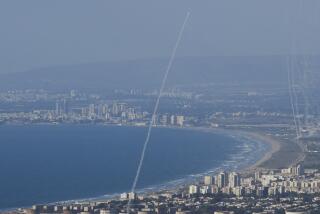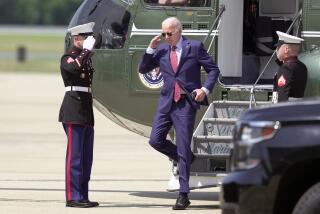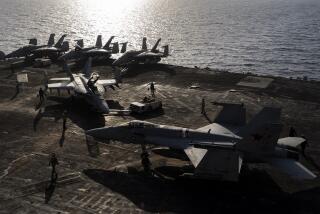Air Strikes Against Libya Suggested by Joint Chiefs : Options for Reprisal Go to Reagan
WASHINGTON — The Joint Chiefs of Staff have sent President Reagan a list of possible military options to use against terrorists in the Mideast, including U.S. air strikes at Libya, government sources said today.
The White House sought preparation for possible military action in the wake of last week’s bomb and gunfire attacks at the Rome and Vienna airports, said the sources, who spoke only on condition they not be named.
Although the list of military actions was prepared, the Pentagon has not taken any major steps toward carrying out air strikes on Libya, the sources said. They stressed that effective attacks would be difficult to achieve.
Leader Believed in Libya
White House spokesman Larry Speakes said Monday that Libya is believed to be harboring Abu Nidal, the leader of a radical Palestinian splinter group suspected of masterminding the airport raids in which 18 people, including three terrorists, were killed.
Speakes also said the United States is seeking the support of its allies for unspecified action to punish the Libyan government of Moammar Kadafi. President Reagan and top Administration officials have long singled out Kadafi as a chief supporter of international terrorism. (Story on Page 8.)
Any U.S. military action against Libya would likely involve U.S. planes flying from the deck of an aircraft carrier or from the nearest U.S. land base, the joint American-Italian base at Sigonella, Sicily.
Carrier in Naples
The Coral Sea, the only aircraft carrier in the Mediterranean Sea, has been in port in Naples, Italy, since before Christmas and is scheduled to remain there until Thursday, the sources noted.
No leaves have been canceled, and even rounding up the Coral Sea’s sailors on short notice would be difficult since many of them probably took advantage of the leave to travel around Italy or ski in nearby Switzerland, the sources said.
The cruiser Yorktown is in port alongside the Coral Sea and its sailors are also on leave, the sources said. The cruiser and its sophisticated Aegis battle management radar would probably play a key role in defending the U.S. planes during an attack.
Other Navy ships remained at ports in Rota, Spain, and Haifa, Israel, Pentagon officials said.
Consequences Studied
The Pentagon sources cautioned that military action against Libya might be difficult to achieve without U.S. warplanes being shot down. They raised the possibility that U.S. fliers might be killed or taken prisoner if that happens.
“People at the State Department and White House keep talking about surgical strikes, but there’s no such thing as a surgical strike,” said one source, if it means hitting only the target and losing no planes.
American and Libyan forces have fought briefly once before during the Reagan Administration. In August, 1981, two Navy F-14 jets shot down a pair of Soviet-made Libyan fighters in a brief dogfight over the Gulf of Sidra, the Mediterranean waters north of Libya where the U.S. Navy was conducting maneuvers.
“But that was over water, that was our turf,” one Navy source said. “It’s different over land. Look at what happened in Syria.”
Two Planes Shot Down
In December, 1983, 28 U.S. warplanes attacked Syrian positions in Lebanon’s central mountains in retaliation for Syrian attacks on the U.S. peacekeeping force which was then in Lebanon.
Two of the American planes were shot down. One American was killed and a second, Navy Lt. Robert O. Goodman, was taken prisoner and held until he was freed early in 1984 during a visit to Syria by the Rev. Jesse Jackson, who was then a candidate for the Democratic presidential nomination.
A U.S. attack on Libya would have to run a gamut of anti-aircraft missiles and Soviet-built Libyan planes. Kadafi has purchased large amounts of military equipment from the Soviet Union in the last decade, including thousands of missiles and planes.
More to Read
Sign up for Essential California
The most important California stories and recommendations in your inbox every morning.
You may occasionally receive promotional content from the Los Angeles Times.










